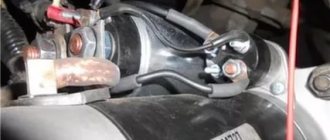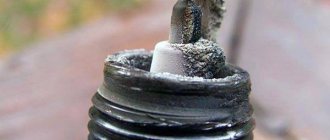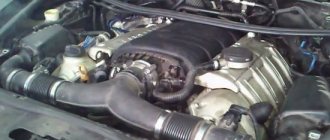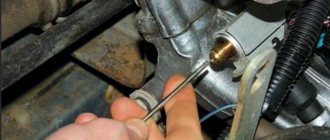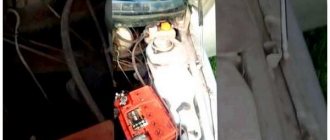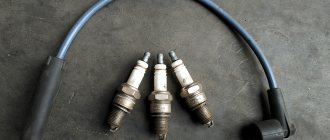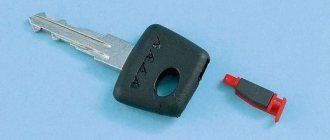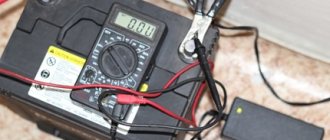I’ll start telling you in order, if anyone has the same symptoms, you will already know what to do...
And so, it all started with the fact that one day the autostart unsuccessfully started the car three times. I started it and it immediately stalled. It was at work, I went out and started the car myself. The engine began to gurgle, as if there was not enough pressure in the fuel rail, and then died. I started it again and pressed the gas pedal, the car seemed to spit out some kind of cork, twitched a little and started up. And then it began to work normally, without problems and without any signs of lack of gasoline or pressure in the ramp. An employee saw this and said that when I accelerated, black smoke came out of the exhaust. You, he says, are filling the candles as you go. This seemed very strange to me, because... The mileage on the car is only 55 thousand. There shouldn't be any problems with the engine yet. It's a bit early. Well, okay, because... I had to go and didn’t have time to figure it out, that day I was ready for it. The employee advised me to contact a diagnostician and gave me a number. But a call to that diagnostician completely discouraged me from going to him - he told me on the phone that: “maybe I’ll see the problem, maybe not, and in general I have lunch and you’ll come when I need it, and not when it’s convenient for you, but Maybe you’ll get a result, maybe you won’t, but you’ll definitely pay money for the diagnosis.” Well, he went to hell then, such a diagnostician. I gave up and gave up on this matter. And in the morning the car started up perfectly, without problems. Well, if that’s the case, then why bother getting into it?
Reasons why it is difficult to start when cold
It is important to distinguish between situations in which problems arise: the car is hot and has difficulty starting, it has difficulty starting after being idle, when it cools down, (especially in the morning) if it refuses to start in cold weather. They all have their own nuances and reasons that should be considered separately .
We will understand in general terms what reasons lead specifically to poor starting of a cold engine. Usually one or two rotations of the starter armature shaft are enough to start a car in good condition. If this cannot be done, you need to look for why.
Main reasons:
| Causes | Carburetor | Injector | Diesel |
| Low fuel quality | |||
| Poor fuel pump performance | |||
| Clogged fuel filter | |||
| Low fuel pressure | |||
| Low fuel level in carburetor | |||
| The pressure regulator in the fuel line is faulty | |||
| Air leak | |||
| Poor condition of spark plugs | |||
| Malfunction of high-voltage wires or ignition coils | |||
| Dirty throttle valve | |||
| Idle air valve contaminated | |||
| Malfunction of air sensor indicators | |||
| Engine temperature sensor glitch | |||
| Valve clearances are knocked down or incorrectly set | |||
| Incorrect oil viscosity (too thick) | |||
| Low battery charge |
In addition to these cases, there may be others, less common, but equally significant. We will also mention them below.
Troubleshooting Tips
On gasoline engines, an indicator that it is difficult to start and stalls when cold can be a spark plug . We unscrew it and look: if it’s flooded, it overflows, we look further down the points; dry - lean mixture, we also sort out the options. This method of analysis will allow you to start finding out with simpler ones and gradually approach more complex reasons for poor engine starting when cold, rather than looking for them in the fuel pump, disassembling the injector, getting into the timing mechanism, opening the cylinder block, etc.
But for a diesel engine, the first on the list of faults will be weak compression . So owners of diesel cars should pay special attention to it. In second place is the quality of the fuel or its inconsistency with the season, and in third place are glow plugs .
Tips for starting the engine in cold weather
- Keep the tank full - this will prevent condensation from forming and water will not get into the fuel.
- Turning on the high beams for a couple of seconds before starting will restore some of the battery capacity on frosty days.
- After turning the key in the ignition switch (on an injection car), wait a few seconds until normal pressure is created in the fuel system, and only then start the engine.
- Pump up gasoline manually (on a carburetor car), but you must not overdo it, otherwise the spark plugs will flood.
- Cars run on gas, under no circumstances should you start them cold, switch to gasoline first!
The injector does not start well when cold
The first thing you should pay attention to when an injection car is performing poorly is the sensors. Failure of some of them leads to difficulty starting the engine, since incorrect signals are sent to the ECU. It is usually difficult to start when cold due to :
- coolant temperature sensor, DTOZh informs the control unit about the state of the coolant, these indicators affect engine starting (unlike a carburetor car), adjusting the composition of the working mixture;
- throttle sensor;
- fuel consumption sensor;
- Mass air flow sensor (or MAP, intake manifold pressure sensor).
Often there is a problem with cold starting due to the fault of the fuel pressure regulator . Well, of course, whether it’s an injector or a carburetor, when a cold car doesn’t start well, if it stalls, the speed jumps, but after warming up everything is fine, then it’s imperative to check the condition of the spark plugs, and use a multimeter to check the coils and explosive wires.
Leaking injectors cause a lot of trouble when it’s hot outside, the car will have difficulty starting on a hot engine, and in the cold season a dripping injector will cause difficulty starting in the morning . To test this theory, it is enough to simply release the pressure from the vehicle in the evening so that there is nothing to drip, and look at the result in the morning.
We cannot exclude such a banal problem as air leaks in the power system - it complicates starting a cold engine. Also pay attention to the fuel poured into the tank, since its quality greatly affects engine starting.
On cars such as the Audi 80 (with a mechanical injector), we first check the starting injector.
The carburetor does not start well when cold
Most of the reasons that an engine with a carburetor does not start well, or does not start at all, is due to malfunctions of such elements of the ignition system as: spark plugs, explosive wires, coil or battery. Therefore , the first thing to do is to unscrew the spark plugs - if they are wet, then the electrician is to blame.
The main reasons why the carburetor does not start when cold:
- Ignition coil.
- Switch.
- Distributor (lid or slider).
- Incorrectly adjusted carburetor.
- The starter diaphragm or the fuel pump diaphragm is damaged.
Of course, if you pump up gasoline before starting and pull out the choke more, it will start better, but all these tips are relevant when the carburetor is correctly configured and there are no problems with the switch or spark plugs.
Advice from an experienced VAZ 2110 car owner: “When the engine does not start on a cold engine, you need to smoothly press the gas pedal all the way, turn the starter and release the pedal back, as soon as it grabs, keep the gas in the same position until it warms up.”
Let's look at some typical cases when it won't start when cold:
- when the starter turns but does not engage, it means either there is no ignition to the spark plugs, or gasoline is not flowing either;
- if it seizes, but does not start, most likely the ignition or, again, gasoline is faulty;
- If the starter does not turn at all, then the battery is probably dead or something related to it.
Why is it difficult to start a cold carburetor?
If everything is normal with oil, spark plugs and wires, then the ignition may be late or the starting valve in the carburetor is not adjusted. However, there may also be a torn membrane in the cold start system , and the valve adjustment also says a lot.
Supply system
The third reason is various malfunctions related to the power supply or engine control system. For example, if any hose or unit is depressurized, the fuel pump or pressure regulator fails, the engine will not start.
Here you can no longer do without diagnostics at a service station - a thorough check of all engine systems is necessary. If a malfunction is detected, the faulty part or assembly should be replaced.
Difficult to start on cold diesel
As you know, starting a diesel engine occurs due to temperature and compression, therefore, if there are no problems with the battery and starter, there may be 3 main ways to find the reason why a diesel engine does not start well in the morning when it’s cold:
- Insufficient compression.
- No glow plug.
- is missing or interrupted .
One of the reasons that a diesel engine does not start when cold in particular, and poor diesel starting in general, is poor compression . If it doesn’t start in the morning, but seizes from the pushrod, and then there is blue smoke for a certain time, then this is 90% low compression.
Checking engine compression
Checking engine compression with a compression gauge and without instruments with your own hands. How to measure compression in gasoline and diesel engines. Compression diagnostics. More details
An equally common case is when the owner of a car with a diesel engine cannot start a cold engine, but a hot one starts without problems - if there is no glow on the spark plugs . Glow plugs heat diesel fuel until the diesel engine reaches operating temperature completely.
There may be three options why the candles do not work
- the spark plugs themselves are faulty;
- It's the spark plug relay. Its operation is regulated by the coolant temperature sensor. During normal operation, the relay makes quiet clicks when the key is turned in the ignition before starting, and if you cannot hear them, then you should find it in the block and check it;
- oxidation of the glow plug connector. There is no point in explaining how oxides affect contact.
3 options for checking glow plugs
To check diesel spark plugs, you can choose several methods :
- measure their resistance (on an unscrewed spark plug) or an open circuit in the heating circuit with a multimeter (checked in the beeper mode, both screwed into the engine and after unscrewing it);
- check the speed and degree of heating on the battery by connecting to ground and the central electrode with wires;
- Without unscrewing it from the engine, connect the central wire to the positive terminal of the battery through a 12 volt light bulb.
If the spark plugs are working and they are properly supplied with power when the ignition is turned on, then in some cases it is necessary to check the valve clearances. Over time, they become confused and do not close completely when the internal combustion engine is cold, but if you start it and warm it up, they close up and the engine starts normally when it is hot.
Faulty diesel injectors , as a result of natural wear or contamination (sulfur and other impurities), are an equally important aspect. In some cases, the injectors throw a lot of fuel into the return line (you need to do a test) or the fuel filter is dirty.
Interruptions in the fuel supply make it much more difficult to start the engine. So, if the diesel engine stops starting in the morning, regardless of the temperature outside, the diesel fuel is leaving (the return valve does not hold), or it is sucking air, other options are less likely! Air entering the fuel system can cause the diesel engine to have difficulty starting and stalling.
Fuel is out of season or contains foreign impurities . When it is cold outside and the diesel engine does not start or immediately stalls after starting, then the problem may be in the fuel. DT requires a seasonal transition to “summer”, “winter” and even “arctic” (for especially cold regions) diesel fuel. A diesel engine does not start in winter because unprepared summer diesel fuel in the cold turns into a waxed gel in the fuel tank and fuel lines, and also clogs the fuel filter.
In this case, starting the diesel engine helps by heating the fuel system and replacing the fuel filter. Frozen water on the filter element presents no less difficulties. To prevent water accumulation in the fuel system, you can pour a little alcohol or a special diesel fuel additive into the tank, called a dehydrator.
Tips for diesel car owners:
- If, after pouring boiling water on top of the fuel filter, the car starts and works normally, the diesel fuel is summer.
- If there is low pressure in the fuel rail, the injectors are probably leaking and not closing (the operation is checked on a special stand).
- If the check shows that the injectors are pouring into the return line, then the needle in the sprayer does not open (they need to be changed).
10 reasons why diesel engines have trouble starting when cold
If a diesel engine has trouble starting when cold, the reasons can be collected in a single list of ten points:
- Starter or battery faulty.
- Insufficient compression.
- Faulty injector/injectors.
- Incorrectly set injection timing, desynchronization with fuel injection pump operation (timing belt jumps by one tooth).
- Air in fuel.
- The valve clearance is incorrectly set.
- Malfunction of the preheating system.
- Additional resistance in the fuel supply system.
- Additional resistance in the exhaust system.
- Internal breakdown of the injection pump.
I hope that all of the above will help you, and if it does not solve the problem of starting a cold engine, it will at least point you on the right path to eliminating it on your own or with the help of a specialist.
Difficulties starting the engine “cold” arise in different situations. Firstly, leaving the car in the cold for a long time. This could be one night or several weekends. Secondly, the cooling of the internal combustion engine after it has warmed up to operating temperatures, stopped and attempted to restart after some time.
Difficulty starting gasoline and diesel engines has similar causes, but manifests itself in different ways. This applies to engines with carburetor and injection fuel supply systems that have design differences.
In this article we will talk about common problems that lead to additional difficulties when trying to start the engine “cold”, we will give recommendations for owners of cars with power plants running on gasoline and heavy fuel.
Lada Granta engine does not start: reasons, repairs and starting methods
Domestic cars, although constantly progressing in the level of performance, lag slightly behind their Western counterparts. So the situation when the engine of a Lada Granta does not start, for example, is quite common.
Main reasons
Today we will try to understand the reasons why the engine refuses to start.
The fuse for the cigarette lighter has blown
Yes, you heard right. AvtoVAZ designers are so ingenious that they installed a fuse on both the cigarette lighter, the horn, and the immobilizer. If the fuse blows, the car will not start at all.
Immobilizer operation
If the key icon flashes when you start the engine, this indicates that there are real problems. You can open the instructions and start looking for the source of the problem. There you can find a description of each breakdown, as well as the signal that corresponds to it. We are talking about the frequency of blinking of the diode.
If the car does not start until the fourth or even fifth time, then the key may need to be retrained.
Important! Do not confuse a flashing “car with key” warning light with a constantly lit one. If after starting the engine the indicator lights up for about 10 seconds and then turns off, this means that the immobilizer on your car is not activated.
The starter doesn't turn over
Starter location under the hood
The second option would be to operate the starter. In a situation where the immobilizer does not report any problems, we may be talking about the starter. It is easy to determine this malfunction, since when you turn the key you will not hear characteristic sounds. An option for extreme sports enthusiasts, you can try closing the starter with a screwdriver. And if the starter doesn’t turn, then you shouldn’t count on the car starting either.
But the starter may not turn because the battery is discharged. You can check this if the lights on the instrument panel do not light up. Even if they are shining, you will need to turn on the high beams and see if they function normally. If the brightness is low, then such a charge may not be enough to start turning the starter.
You can view the voltage of the on-board circuit in the on-board computer. If the voltage is less than 11.4 Volts, then the starter will not have enough power to crank the engine.
The optimal solution would be to charge the battery or “light it” from someone. Let the car idle for about 10-15 minutes. This will be enough to slightly “restore” the battery power.
The starter under the hood is located at the bottom left
Problems with the starter can also have other sources, namely damaged wiring. In this case, a regular tester will come to the rescue. We connect the red contact to the starter, and the black one to the car body. The indicator should be between 12.5 and 14.5 volts. Finding the location of a breakdown can be difficult, especially in the field.
Starter crackling noise when starting
If you experience a similar situation, then removal and repair of the starter is necessary. Otherwise, you risk simply not starting next time!
Electronic control unit
Above we looked at simple reasons why the Lada Granta may not start. It is much more difficult if the electronic control unit, which is simply called the ECU, fails. People call this element “brains”.
There shouldn't be any problems with the ECU if you don't touch it. But, often, a situation occurs when the surface of this element is filled with antifreeze, due to the peculiarities of its location. (problem of the first Lada Kalina cars).
This plug must be put on tightly (check this if possible)
If your car has had an alarm installed or other interventions have been carried out, the plug that prevents moisture from entering may not be fully seated. This leads to subsequent breakdown of the “brains”, which are almost impossible to repair. The entire system will have to be changed.
Can't start due to faulty spark plugs?
Looking for complex and sophisticated reasons, we forget about the simplest breakdowns, such as failure of spark plugs. Moreover, they could simply be “flooded”. Basically, this happens in the winter season, since compression goes beyond normal limits and the engine does not start the first time.
Difficulties in the operation of spark plugs can also arise if the battery power is insufficient, as a result of which it is impossible to provide a normal spark.
Blowing spark plugs
Drying candles is quite simple. To do this, the gas is pressed to the maximum to the floor, and the engine is turned by the starter for ten or fifteen seconds. As a rule, this is enough. If the engine still does not start, then you will have to take out the spark plugs and dry them.
On carburetor cars, you had to take out the spark plugs and “pierce” them
It would be a good idea to clean the surface of the candles with a toothbrush or other not very hard tool. Just don’t overdo it so that the gap remains the same. A harbinger of problems with spark plugs may be an unstable engine.
We only fill with the correct fuel
AvtoVAZ recommends using only 95 gasoline. But I have no problems starting the engine even on 92 gasoline.
But, if everything is fine with the car itself, then perhaps the problem lies in the quality of the fuel? The fact is that such gasoline, especially in winter, can release moisture, which settles on the coarse filter, preventing its further functioning. To prevent this, try to keep at least 25% of the tank's volume in the gasoline tank. In the case of the Lada Granta, this is one quarter of 50 liters!
If the car was driving before, but smoked heavily, rang and made unpleasant sounds, then this may indicate problems with fuel. This may be the result of savings, or refueling at “random” fuel stations. In this case, you will need to drain all the gasoline, otherwise when driving on such “hellish” fuel, the fuel system (injectors, spark plugs, fuel line, fuel filter) may “crash”.
In the most difficult cases, even filters and nozzles can become clogged. And it is impossible to quickly wash them. But such bad gasoline is now very rare.
Fuel pump and fuel filter as the cause of poor engine performance
Location of the fuel pump in Grant
Some problems may include whims from the gasoline pump. You can notice this by the fact that the starter works normally, but the engine does not work, and the sounds of the fuel pump are not heard at all.
The breakdown may be located in the area from the fuel tank to the fuel rail. Fuel hoses could become clogged, into which dirt was passed through by a faulty (clogged) fuel filter.
To check the pressure in the system, you need to open the hood and find the injector ramp on the left side. There the cap, painted black, is unscrewed to get to the nipple. If you press it, fuel should spray out.
If gasoline flows, then the problem is not in the pump. But if there is no gasoline, it is worth checking the battery to find out whether the pump is supplied with power. You can also lift the backrest and check the voltage at the fuel pump terminals.
Very often the reason is the relay. A certain “folk” method would be to unscrew the casing to get to the power coils. You need to knock on them a little, or just warm them with the warmth of your hands.
A broken timing belt will prevent the engine from starting.
You shouldn’t skimp on a timing belt; it’s not something you can buy on the cheap!
The problem may be with the timing belt. It is impossible not to notice this, since the belt breaks while moving. And, if this is not the “weakest” version of the Lada Grant, then it also bends the valves. This occurs due to the fact that the valves temporarily meet the pistons, which leads to the specified breakdown.
More information about replacing the belt on a Lada Granta:
- 8 valve models
- 16 valve models
It is impossible to insure against this. Check the condition of the belt periodically. An alternative would be to install special pistons with grooves, which will help avoid serious problems, even on 16-valve engines.
It is not uncommon for the pulley to be turned a little. Even a couple of teeth will provide incorrect information from the sensor, and the engine will not start. To do this, you need to check the mark on the pulley and belt.
Crankshaft sensor
Old and new crankshaft sensor
A rather exotic problem is the breakdown of the crankshaft sensor. It needs to be removed and connected to the tester set to voltmeter mode. Now we quickly move it in front of its side with a steel screwdriver. This should lead to voltage surges.
Or you can simply measure the resistance. To do this, we install the tester for continuity, and make sure that it gives a result of 750 Ohms.
Video check of DPKV (crankshaft sensor)
If this is not the case, then it is worth replacing the sensor with a new one.
conclusions
Not any error may mean that the engine will not start. For example, there are errors that simply indicate that you need to pay attention to a certain node.
For example, error 0830 - Clutch pedal switch, circuit faulty - this error does not affect engine starting in any way!
Preparatory activities
To simplify your task in finding the cause of the malfunction, check the following:
1. Presence of exhaust gases.
There should be light smoke coming from the exhaust system when the starter rotates. It indicates that fuel is entering the cylinders.
2. Battery charge level.
A completely discharged battery is one of the most common reasons why a car engine will not start. Therefore, we check the battery charge level.
3. Serviceability of the starter (the engine should spin without failure).
If the starter does not spin the crankshaft, then a dead battery is to blame. If not, then the problem lies elsewhere. For example, the contact between the ground and the starter housing has oxidized.
The main reasons for poor cold starting.
Judging by the problem described above, there may be several reasons for the malfunction, and you need to start with the one that you think can be solved most quickly.
The reasons may lie in the following:
- Poor quality gasoline - try changing gas stations.
- Pay attention to the quality of the fuel - there may be a lot of water accumulated in it.
- Check the ignition module for functionality.
- Diagnose spark plugs and high-voltage wires - spark plugs for breakdowns, and wires for cracks; if anything like this is found, then this element should be changed.
Location of spark plugs and protective caps
This is a list of the main reasons why an engine may start poorly when cold.
Service or DIY repair?
Some causes can be diagnosed by yourself, but most of them will require replacement parts. Usually electricians have “guaranteed working” spark plugs, armored wires, and also if they have special ones. equipment (CO emission standards), you can check the operation of the ignition.
In order to solve the problem, contact a specialized car service for diagnostics, or do it yourself if you have a diagnostic cable and suitable software.
The main causes of problems during cold engine starts
Low quality fuel
The likelihood of refueling a car with low-quality fuel at certified gas stations in large cities is very low. It is much easier to encounter counterfeit products at little-known gas stations on the highways or when purchasing fuel second-hand. Such fuel does not pass quality control and contains a large amount of impurities that contaminate filters and fuel pipe channels. As a result, the pressure in the system decreases and the car does not start.
The use of low octane gasoline is determined by the following criteria:
- too noisy operation of the internal combustion engine;
- reducing the dynamic characteristics of the car;
- detonation.
In diesel engines, a problem may arise due to the fuel selected “out of season.” An owner who uses diesel fuel for the summer during the winter period of operation of the vehicle will encounter difficulties. The main reason is the discrepancy between the physical and chemical properties of the fuel and the operating conditions.
see also
“Peter - AT” INN 780703320484 OGRNIP 313784720500453
The saga of Injectors and left Lukoil
One fine morning I came to the garage to pick up the car, and it was 200 km from home, I started to start it and suddenly it started only after spinning the starter for a long time. This was the first time in 14 thousand kilometers and I was very surprised by it. I thought it was a problem with gasoline, the day before I filled up a full tank of 92 at Lukoil. But since I rode very actively that weekend, I managed to spend two full tanks of gas, and nothing changed. The car began to start in 2 out of 3 cases after prolonged rotation with the starter. I went to the dealer where I bought the car. We connected the DST and showed one error: an open circuit in the fuel pump. I have an alarm with a relay for a broken fuel pump, and when they heard it, they immediately sent it to three letters, that is, to the service station where I installed the alarm, not the officials by the way, but of course I didn’t tell them that. In theory, this is the reason, but I was alarmed by the fact that the problem was only with the start, the engine itself works fine and pulls perfectly. I had already driven 1.5 thousand km and didn’t notice a lack of gas pressure. After changing the fuel pump switch and then eliminating it altogether, the problem did not go away. Then I stopped at another service station, where they washed my throttle valve and again nothing. And finally, after almost 3 thousand km of driving with such nonsense, I ended up at the VAZ service station. After waiting in line for 4 hours, my car was finally accepted, taking into account that the order was issued at 8:11 am immediately after opening. And now I'm finally at the diagnosis. Whatever the diagnostician did to the car, started and turned off exactly 100 times, poor starter. As a result, there is a problem with the launch, but the reason is not exactly clear. But I won’t go into detail about what he did with it, for 2.5 hours of work, let’s go straight to the result, and the result is that the injectors are 90% to blame. Many masters referred to them, but no one could say for sure. As a result, we connected the monometer to the ramp, the pressure was excellent, but as soon as the pump was turned off, the pressure began to drop quite actively, and then we were faced with the question of who is to blame: the injectors or the pump does not hold. We unscrewed the gas line tube from the ramp and connected a pressure gauge to it, the pressure drops, but very slowly, we hook everything back to the ramp and the pressure drops much more actively, hence the conclusion that it is the injectors that are to blame. After the engine is turned off, the residual pressure in the ramp forces gasoline into the cylinders and fills them completely, so the engine cannot start immediately unless you press the gas pedal. If at first, after pouring this waste into the tank, the injectors clogged up and they closed very weakly and poured gasoline into the cylinders immediately and the car did not start after 1-2 minutes of inactivity, then after some mileage they apparently broke through a little and began to close better and the car I started having trouble starting after 20-30 minutes of inactivity.
The result of the warranty providers: the injectors are not subject to warranty, you filled up with crap gasoline and we have nothing to do with it. Since the matter is not covered by warranty, we will not do anything and you will be charged 380 rubles for diagnostics and troubleshooting. Of course, I was very indignant, but in principle I agreed. With this I said goodbye to them. They didn’t fix the problem, but at least they told me what the reason was. Now I’m wondering what to do with them, clean them or change them right away? Who can tell me what about this?
Possible faults
No matter how trivial it may sound, if the injector does not start, it means something has gone wrong. The success and speed of repair depends on how quickly and efficiently the problematic link in the car’s design can be identified. To better understand the essence of repair activities, it would be a good idea to pay attention to potential breakdowns. The basic list of the latter is as follows:
- Malfunctions of the injector itself. In the event of a breakdown of this kind, as a rule, the car does not start either cold or hot. On top of that, the injector indicator on the dashboard or on-board computer constantly lights up, signaling its malfunction. It is much less common for the engine to work when the indicator is on, but in this case the car starts poorly and is extremely unstable. It is worth noting that the injectors in the injector most often become clogged or the ECU burns out, so it is advisable to check these components first;
- Ignition system failures. Here the list of possible faults is quite large. Often the candles that suffer are simply flooded. In the event of such a breakdown, the car starts and immediately stalls, but in the long term it stops even “grasping.” Other components of the ignition system (coil, module, distributor, crankshaft sensor, etc.) are noticeably less likely to suffer;
- Incorrect operation of the fuel system. In this aspect, injection engines most often suffer on three fronts:
- Fuel filters are clogged (the car “picks up”, but does not start; if the engine starts, it is extremely unstable);
- The fuel pump is faulty (its characteristic operating sound is absent when you turn the ignition key, the injector itself simply does not start both cold and hot, the starter turns).
- There is insufficient pressure in the fuel system (the engine starts up reluctantly both cold and hot, but if it starts working, it functions unstable);
- Engine problems. Perhaps the widest range of possible malfunctions. Often the reason lies in weak compression or incorrectly adjusted valves. In any case, with a “motor” starting problem, high-quality engine diagnostics are required, otherwise it will be very difficult to determine the cause of the malfunction.
In addition to the breakdowns described above that can break the operation of the injector, the problem may lie in more trivial things. An example of this is a weak battery charge or lack of fuel in the tank. Considering just such incidents, before repairing a car, it is extremely important to exclude the possibility of their occurrence, so as not to waste extra time and nerves.
The starter turns, but the engine does not start
If the starter rotates after turning the key, but the engine does not want to work, then there may be enough reasons.
The first and most obvious is the lack of fuel in the car’s tank. Often the fuel level sensor lies even on new cars. It is worth checking the level in the tank and, if necessary, adding fuel. After this, you can try to start the engine. It is also worth keeping in mind that the level sensor shows an incorrect value at low air temperatures.
The procedure for returning the car to “life”
Let's say you find yourself in circumstances where the injection engine starts poorly or refuses to do so at all. There is no need to hesitate in such a situation - it is advisable to immediately begin resuscitation procedures. If you don’t have time to figure out the exact reason why the car doesn’t start well, then you should quickly carry out the following algorithm of actions:
- First of all, we check the availability of gasoline and battery charge. Is there something missing? Fill it up and light it up. Let's try to start. If there is no result, proceed to the next step;
- Next, we quickly analyze under what circumstances the car malfunctions. If it takes a long time or is difficult to start when hot, we first check the spark plugs for overheating (light carbon deposits) and the functioning of the fuel system. Otherwise, when the car malfunctions both cold and hot, a more comprehensive approach is required. As a rule, the following procedures are sufficient: checking spark plugs, wiring the ignition system, assessing the operation of the injector and fuel system;
- Note that most motorists manage to solve the problem, so to speak, with little loss, that is, by implementing the actions described above. If you are not one of the lucky ones and your car still takes a long time, starts poorly or refuses to work at all, you will have to act globally. Here it is better to take the car to a service station or a convenient garage and check the compression, timing adjustment, clean the injector, assess the condition of the fuel system and ignition devices. If there are any malfunctions, they must, of course, be eliminated.
In general, there are no particular difficulties in repairing a non-starting injector. The main thing in the process of such work is to act competently, in accordance with the procedure and possible vehicle malfunctions described above.
Starter
If the Lada Granta does not start, the starter does not rotate, then there may be a problem with it. There may be many different interesting and not so interesting options.
The starter does not spin if the contact is broken, if the brushes are worn out, or the stator or armature is shorted. Also sometimes the cause is a malfunction of the solenoid relay. It is not capable of closing power contacts.
The first step is to check the entire electrical circuit to the starter. The wires to it are thick, at first glance they are quite normal. But inside they consist of a mass of thin veins. Over time, the wire may wear out and burn out. Often contact is broken in the terminals, which, again, at first glance, look quite normal. If the terminal to the starter has oxidized, then finding the place is quite simple - it will get very hot.
The wires are connected to the solenoid relay, and the contacts are copper bolts. Copper is highly oxidized. And if there is no quality contact, then the starter will turn, but the engine is unlikely to start. You should clean these bolts on the solenoid relay, the wire contacts and try to start the engine. If the starter is working properly, the car will start.
Prevention of injector breakdowns
Why the injection engine does not start and how to eliminate possible problems is now known to all readers of our resource. However, it is better to avoid such breakdowns, so let’s pay attention to ordinary procedures that, if carried out systematically, will help minimize the risks of all malfunctions. The simplest but most effective prevention consists of the following measures:
- Firstly, refuel exclusively at proven gas stations and only with high-quality fuel. Remember that most fuel system and engine malfunctions are caused by dirty gasoline;
- Secondly, change all consumables on time and only with high-quality products. The most important thing is periodic replacement of all kinds of filters and engine oil;
- Thirdly, periodically check the main components of the machine for stability. The list of the latter, naturally, includes the injector, elements of the fuel system, ignition and engine;
- Fourthly, never neglect routine diagnostics of your car at a service station. Surprisingly, even a delay of a couple of hundred kilometers can cause serious damage, which previously could have been eliminated with very simple actions;
- And fifth, always operate your vehicle properly. That is, you do not need to overheat, overload or negatively impact your car in any other way.
Perhaps this is where the most important information on today’s issue has come to an end. We hope the material presented above was useful and provided answers to your questions. Good luck in operating and maintaining your car!
Ignition system
It is also worth checking if there is a spark. If the Lada Granta does not start, then, as in old carburetor models, there is either nothing to burn or nothing to set on fire. If there is gasoline, but the car shows no signs of life, then it is worth checking the ignition coil and the entire electrical circuit that serves the coil. Perhaps a contact has oxidized somewhere and this is the reason for the missing spark. After cleaning the contact it may appear. Also, if the coil is faulty, it should be replaced.
All other reasons when the Lada Granta does not start are related to the engine itself. Often the crankshaft position sensor on Grants fails. In addition, problems may be in the circuit of this sensor.



